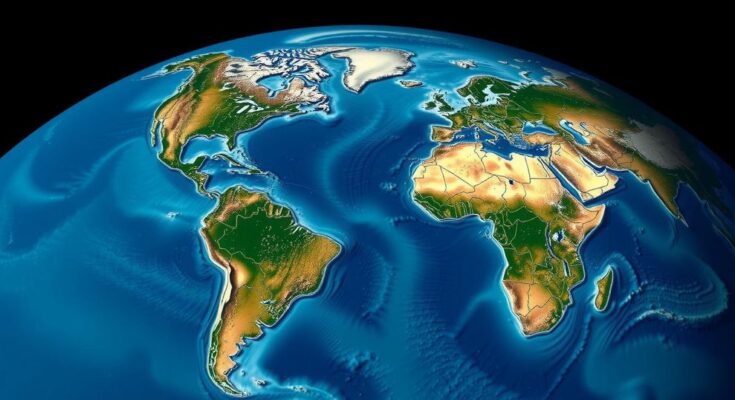A comprehensive study utilizing NASA satellite data has revealed a significant decline in global freshwater resources since 2014. The study suggests that this trend may signal a more arid climate ahead, highlighting severe drought patterns and their repercussions on human communities and agriculture. The interconnections among climate change, extreme weather, and freshwater depletion are underscored, fostering urgent discussions on global water resource management.
According to a recent study utilizing NASA and German satellite data, a significant decline in Earth’s freshwater resources commenced in May 2014 and has persisted in subsequent years. Published in “Surveys in Geophysics,” this research indicates that this trend may signal a shift towards a long-term, drier climate for Earth’s continents. From 2015 to 2023, satellite observations indicated a reduction of 290 cubic miles in land-based freshwater, including rivers, lakes, and aquifers, surpassing the combined volume of Lake Erie. Matthew Rodell, a NASA hydrologist and co-author of the study, emphasizes the profound implications of dwindling freshwater supplies, particularly in the context of increasing drought frequency and reliance on groundwater, which creates a self-reinforcing cycle of depletion and inadequate replenishment. The analysis highlights that rapid groundwater extraction during droughts exacerbates shortages, leading communities and agricultural sectors to face heightened risks of famine, conflict, and disease due to reliance on contaminated sources. The researchers leveraged data from the Gravity Recovery and Climate Experiment (GRACE), a collaborative mission between NASA and the German Aerospace Center, which monitors global water mass fluctuations through gravity changes. Notably, drought conditions first emerged in northern and central Brazil, subsequently affecting broad regions across Australasia, North America, South America, Europe, and Africa, exacerbated by climatic phenomena such as the intense El Niño event from 2014 to 2016. Despite the abatement of the El Niño, freshwater levels have not rebounded, with 43% of the most severe droughts recorded by GRACE satellites occurring post-2015. The correlation suggests that climate change may significantly contribute to this persistent decline, as rising global temperatures lead to extreme weather patterns that hinder groundwater replenishment. NASA meteorologist Michael Bosilovich remarked that prolonged dry spells following heavy rainfall impede water absorption into the soil, resulting in diminished groundwater reserves, ultimately exacerbated by increased atmospheric evaporation due to warming temperatures. Furthermore, hydrologist Susanna Werth notes the complexities in linking climate change directly to freshwater decline due to ongoing uncertainties within climate models and empirical measurements. In conclusion, whether global freshwater levels will stabilize, recover to pre-2015 figures, or continue to decline remains uncertain. The concurrence of the most intense years of heat with the onset of the freshwater depletion trend strengthens the assertion that this phenomenon may in fact be related to global warming. Rodell cautioned, “We do not think this is a coincidence, and it could be a sign of what is to come.”
This article discusses a systematic decline in global freshwater resources, established through satellite data, emphasizing the potential long-term implications of climate change on water supply. The focus lies on the synthesis of research findings that uncovered a continuing reduction in freshwater starting in 2014, underscoring the connection between extreme weather events, specifically increased drought conditions, and the challenges faced by human populations reliant on stable water sources for survival and agriculture. The data elucidates how the interplay of climate change and shifting weather patterns is driving significant alterations in global freshwater availability.
The ongoing decline in global freshwater resources since 2014, as evidenced by satellite data, raises significant concerns about the potential impacts of climate change and drought on water availability worldwide. Researchers emphasize the necessity for further examination of these trends and their implications for communities reliant on freshwater, suggesting that the observed patterns may correlate with broader climatic shifts. The ability of ecosystems and populations to adapt to these changes is under scrutiny, with calls for strategic actions to mitigate water scarcity risks.
Original Source: www.businesstoday.in




